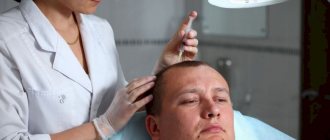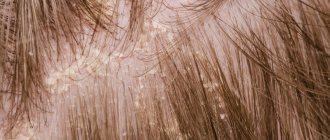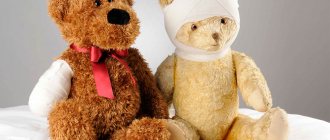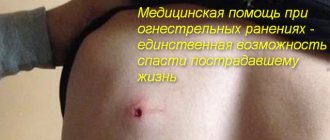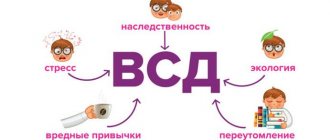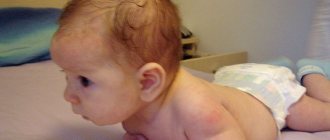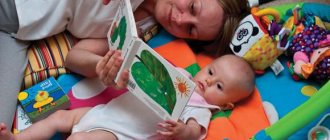Symptoms of torticollis in an infant
2-3 weeks after birth it will be possible to diagnose torticollis. It is not possible to identify any signs and symptoms of the disease earlier. You or your doctor should be alert to some symptoms and signs of torticollis in an infant.
- Muscle compaction in the cervical area (right or left).
- Baby crying if you touch a problem area.
- Constantly keep your head to one side.
It is these symptoms that signal that the baby has signs of torticollis and needs help. If you notice such signs (symptoms), then you need to think about the fact that torticollis has already begun to develop in your baby. Timely noticed symptoms mean successful treatment of torticollis.
Causes of torticollis
The cause of congenital torticollis in infants is increased muscle tone. This condition for babies is one of the normal variants, which is why this type of torticollis is also called “false”. The causes of pathological torticollis may be associated with the following points:
- injuries to the muscles of the upper spine and neck during childbirth;
- dysplasia, that is, congenital pathology, of the cervical muscles;
- incorrect position of the fetus in the womb;
- compression of the muscles at the time of childbirth, as well as strong entanglement of the umbilical cord in this area;
- prolonged hypoxia;
- difficult course of childbirth and so on.
In the period after birth, torticollis can be caused by various diseases leading to paralysis, spasms and other changes in the neck muscles. The most common installation form of torticollis is associated with the position of the child predominantly on one side. Other types of torticollis are not very common in infants.
Muscular torticollis in infants
Muscular torticollis in infants occurs as a result of injuries during childbirth. In this case, muscle damage is almost always unilateral; damage to the right side is more often observed. Compression or stretching of the neck muscles leads to local inflammation and hemorrhage, which leads to thickening and shortening of the sternocleidomastoid muscle.
In the absence of proper treatment, muscular torticollis in infants progresses and becomes more pronounced. In the future, this condition in a child can cause disruption of the correct development of the shoulder girdle and the appearance of scoliosis. In the most advanced cases, the consequences of torticollis include changes in the palate, facial features, ear canal, decreased vision and hearing.
Installation torticollis in infants
The reasons for the development of torticollis in infants are improper organization of the child’s sleep and play. This form of pathology occurs in children of the first year of life. Torticollis is formed when placing toys on one side of the crib or stroller, constantly laying the child on one side, or carrying him on the same arm.
If treatment for installation torticollis is started in a timely manner, the prognosis is usually favorable. In this case, all the symptoms of the pathology disappear after a couple of months without a trace.
Among other things, in children with torticollis, the lymph nodes located in the neck often become enlarged, and the normal blood supply to the brain is disrupted, as the carotid and vertebral arteries are compressed. These babies are more likely to have colds.
Right-sided torticollis in an infant
As already mentioned, right-sided torticollis is more often observed in infants, which is associated with pathological disorders of the sternocleidomastoid muscle. The manifestations of this form of the disease are similar to others. In treatment, it is important to make the correct diagnosis in time and begin therapy. In this case, it is usually possible to eliminate torticollis quite quickly with the help of massage and other simple procedures. If the disease is advanced, surgical treatment may even be required.
Reasons for the development of torticollis in a newborn
There are several causes of torticollis in a newborn:
- Violation of the structure of the spine or deformation of the vertebrae (one or more).
- When there is pressure on the fetus when the baby is in the womb. In this case, the baby's head is not positioned correctly.
- The neck muscles can lose elasticity and become shorter due to the occurrence of intrauterine inflammation, which becomes chronic.
- The neck muscle can also tear during a difficult birth. In this case, the muscle fibers pass into the tendons, and a scar forms at the site of the tear.
- The presence of malformations in the mastoid muscles.
According to most orthopedists, as well as Dr. Komarovsky, torticollis in newborns is a congenital defect, which most often the baby receives precisely during the birth process. Moreover, even a caesarean section is not a guarantee that the child will be able to avoid such a pathology. It has also been observed that babies who are born with their buttocks suffer the most from torticollis. To determine the exact cause of torticollis in a baby, you need to undergo several examinations with different doctors - an orthopedist, a neurologist and a pediatrician.
But you shouldn’t delay the treatment of torticollis in a child. Once a problem is discovered, treatment should be started immediately. After all, the forced position of a baby’s head almost always leads to disturbances in the asymmetry of the skull and face. If the disease is not cured in infancy, then in the future it will lead to curvature of the spine, and it is easiest to treat torticollis during the newborn period.
Causes
Torticollis in a newborn child can be either congenital or acquired . These 2 forms of the disease have different causes of occurrence and development.
| Congenital form | Acquired form |
| This form is relatively rare and occurs due to reasons such as:
|
Read about the symptoms and signs of Down syndrome in a newborn here.
Treatment of torticollis in older children and infants
Today, there are several methods for treating torticollis, some of which need to be combined in order to achieve the desired result.
- Therapeutic gymnastics and massage. These procedures should be carried out by specialists or mothers who have undergone professional instruction.
- Physiotherapeutic procedures.
- Treatment by changing head position.
- Using a bathing circle.
- Applying a special collar (Shants collar).
- Therapeutic water procedures.
If torticollis is caused by some disease, then it must be treated.
Massage for newborns at home
If you are absolutely sure that you can massage your baby yourself, or you do not have the opportunity to get professional help, then we suggest you familiarize yourself with the massage technique for torticollis.
- Place your baby on his back. Lightly massage your arms, legs and chest using stroking movements. Remember very carefully the muscle located on the side of the torticollis. Rub the opposite side with your palms and stroke it.
- Rotate your baby's head slightly, turning it first one way, then the other.
- Stroke the belly, massage the neck again, then remember the baby’s feet.
- Turn the baby onto his stomach and lightly stroke his neck and back.
- Now you need to turn the baby from one side to the other. This exercise helps to straighten the back.
- Finally, stroke your baby's arms and legs.
This massage should be done regularly. Its duration should be 6-9 minutes, 2-3 times a day.
Why does installation torticollis occur?
Most often, this condition occurs when the child often lies on one side with the head turned to one side. The reasons for this may be the following:
- Parents always put their baby to sleep on the left or right side.
- The location of the crib in the room is such that it can only be approached from one side (the baby turns his head when someone approaches him).
- Mom places toys only to the left or right of the baby.
With constant fixation of the head on one side, shortening of the sternocleidomastoid muscle occurs, which is manifested by a typical clinical picture.
Sometimes the cause of installation torticollis is pathologies of the respiratory system, in which the child has difficulty breathing in the supine position. In such cases, he turns his head to the side to relieve the condition.
Treatment by changing position
Most problems in a child associated with torticollis can be resolved at home. Komarovsky advises parents to treat with position. This technique, which promotes passive stretching of the affected muscle, should be performed regardless of whether the baby is in your arms or lying in a crib. Remember that incorrect head position should not become natural for the baby, and it is the parents who are responsible for this.
Treatment by position includes several rules:
- The baby should sleep on a hard mattress without a pillow. Instead, you need to fold a diaper.
- The child should not sleep with the neck turned in the problematic direction. To do this, place some toy on the side of the damaged muscle or turn on the light; when the baby turns his head in the “forbidden” direction, he will feel uncomfortable.
- You can also use special salt bags that can be used to fix the baby’s head in the correct position so that his shoulders lie symmetrically. Do not place your baby this way if he burps frequently. If you are placing your child on the sore side, be sure to place a high pillow under his head.
Torticollis in infants: treatment methods
Manifestations of torticollis in an infant and external symptoms are clearly visible in the photo, but treatment is prescribed after a thorough diagnosis and determination of the cause.
Did you know? Treatment strategy for newborns may include: massage, positioning therapy, gymnastics, magnetic therapy, electrophoresis, surgery.
The muscles of newborns are still very soft and pliable, so conservative methods are suitable for treatment. Therapeutic treatment includes ensuring a special position during sleep, the use of orthopedic structures, for example, the Shants collar, gymnastics, and electrophoresis.
Physiotherapy
Physiotherapy for newborns is prescribed to improve nutritional and metabolic processes in the affected area and improve blood flow. Physiotherapeutic procedures include: infrared irradiation, paraffin therapy, electrophoresis, therapeutic massage, exercise therapy.
Massage
Its goal is, on the one hand, to relax the neck muscles and bring them to a natural position. On the other hand, massage increases tone, relieves inflammation and activates blood circulation. Massage for torticollis in infants is performed for both the sick and healthy side.
Basic principles of massage procedures for torticollis:
- for the injured side, use only relaxing movements (vibration, gentle rubbing, stroking);
- For healthy muscles, both relaxing and tonic techniques are used: pressure, effleurage, vigorous rubbing, acupressure movements;
- During the massage, the newborn's head should be turned to the affected side to avoid unnecessary stress on the sore muscle.
To achieve a healing effect, massage is carried out from three to 5 times a day, in courses of 10-20 days. Duration of each session: up to 15 minutes. The sooner massage procedures are started, the better the result will be.
When performing a massage, pay attention to the following nuances:
- the movement is directed from top to bottom: for example, with two fingers, stroking the neck alternately on both sides in the direction from the ear to the collarbone;
- vibration can be done with the palm of your hand, placing it on the muscle;
- the tense thickening in the sore muscle is gently rubbed, gently kneaded and gently stroked;
- After relaxing techniques, you can do a light stretch: place your thumbs in the center of the affected muscle and smoothly spread them in different directions, thus stretching the muscle tissue.
Treatment by position
This static method must be included in the course of conservative treatment. The newborn should be positioned so that objects that attract attention are on the affected side. The mattress is selected with medium hardness, the edge of the headboard should be raised at an angle of 15-20 degrees. To do this, use a rolled up diaper or select a special orthopedic pillow model.
Twice a day the newborn is placed in the corrective position for 1.5-2 hours. To do this, partial bags of cereal or salt are placed on both sides of the newborn’s head, and fabric rolls are rolled along the armpits. This is done in order to give a symmetrical position to the body and head.
Physiotherapy
Gymnastic exercises are done at home, usually in the morning and evening. It is best when the complex is carried out by two adults: one holds the newborn’s body in the desired position, and the second controls the movements of the head.
Exercises in water, so-called aqua gymnastics, help with torticollis . The water temperature should be comfortable - about 36 degrees. The first few times the instructor shows the exercises, then the parents do it, and the instructor observes and corrects, and later you can do the water exercises yourself.
Physiotherapy
One of the best ways to treat torticollis in newborns, as Komarovsky assures, is gymnastics. However, not all mothers are able to carry it out at home, because these procedures are very painful, and it is difficult for a loved one to continue treatment, knowing that they cause pain to the baby. Yes, and you need to know the gymnastics technique perfectly, and all your movements should be as careful as possible. It is best to carry out therapeutic exercises together.
- Have one person hold the baby's arms and body and hold them. The second person should hold the baby's head. In this case, the child’s shoulders should be at the edge of the table, but the head and neck should be supported (at first the baby’s head must be held securely, but then the support can be gradually reduced).
- Gently take the baby's head and point it towards the body. It is ideal if the baby's chin can touch the chest.
- Exercises are carried out daily, after waking up in the morning and an hour before going to bed in the evening.
You can also do gymnastics when you simply pick up the child in your arms. To do this, you need to slightly reduce your head support day by day. This will allow it to hang down under its own weight, allowing the muscles to stretch. This exercise must be done very carefully, and if the baby does not yet know how to hold his head up, then you need to exercise maximum caution, avoiding a complete loss of control over the baby’s head.
Although therapeutic exercises are effective, they must be combined with electrophoresis and massage. Usually, only a couple of courses are enough for noticeable results. But parents must understand that to fully consolidate success, 4-5 courses of massage and gymnastics will be required, otherwise the problem may reappear.
Installation torticollis in a child
Home page » Curvature » Torticollis
Pathologies of the musculoskeletal system in young children are common. One of them is installation torticollis. It is a curvature of the cervical spine.
It appears most often in newborn girls. The disease is highly treatable. The main thing is to remember a few basic tips and tricks.
What is installation torticollis?
Installation torticollis in newborns most often has an acquired nature. It is not associated with insufficient length of the sternocleidomastoid muscle and improper formation of the cervical spine, like other types of this disease.
This pathology appears as a result of illiterate care for the baby. If mom constantly puts him in the same position or puts a toy in a certain place, then a habitual head tilt may form.
Over time, this condition becomes fixed, and a strong tilt of the skull to the left or right is observed. Children raised in orphanages often suffer from this problem.
Timely diagnosis and treatment will help avoid serious consequences. The use of modern techniques will quickly eliminate the disease.
What types of torticollis exist?
Torticollis can be not only acquired, but also congenital. Depending on the characteristics of the pathology, the following types are distinguished:
- Neurogenic. It becomes a consequence of oxygen starvation of the child’s brain in the womb. Sometimes provoked by intrauterine infection.
- Muscular. This type of pathology can be either congenital or acquired. Associated with insufficient strength of the sternocleidomastoid muscle.
- Osteogenic. Caused by the malformation or fusion of an infant's vertebrae.
- Desmogenic. Acquired disease. It is observed after infectious diseases, damage to the lymphatic system or skin problems.
- Compensatory. Becomes the result of a sharp decrease in hearing or vision.
- Installation. Develops against the background of improper care of the baby.
Torticollis is also divided into left- and right-sided, depending on which shoulder the head leans towards. Right-sided torticollis is more common. If it is diagnosed in time and treatment is started, surgical intervention will not be required.
Causes of pathology
Installation torticollis in infants is quite common. This is due to the fact that new mothers do not take into account all the features of caring for the baby. Among the main causes of the disease are:
- Constant placement of the baby's favorite toy on the same side of him.
- Putting your baby to sleep on the same side.
- Improperly carrying a baby in your arms.
- Birth injuries.
The child’s musculoskeletal system is just beginning to form, so it is susceptible to the negative influence of external factors. Timely identification of the cause of the pathology and compliance with the rules of care for the newborn will help to avoid complications.
The main signs of installation torticollis
Most often, parents are not able to identify the problem on their own. Therefore, regular examination of the child by a doctor is important. If treatment is not started in time, the sternocleidomastoid muscle will gradually begin to contract and changing the position of the head will be very problematic.
Among the main signs of torticollis are:
- Tilt of the head in a certain direction.
- When trying to position the head straight, the child resists, as he experiences unpleasant sensations.
- Facial asymmetry may appear.
- One shoulder is raised higher in relation to the other.
- Over time, a depression forms between the neck and the shoulder towards which it is inclined.
- Enlarged lymph nodes.
- Increased pressure on the carotid artery, resulting in decreased blood supply to the brain.
- The child often suffers from infectious diseases.
Such symptoms should serve as a signal for immediate treatment. Only a pediatrician can develop the correct method of therapy.
Possible complications
As soon as you notice alarming symptoms in your baby, seek help from a doctor. Delayed diagnosis and treatment lead to the development of complications. There may be:
- Deformation of the spine or skull.
- Degenerative changes in the muscles of the face and neck.
- The appearance of severe headaches.
- Cerebrovascular accident. The result of this is deterioration of hearing and vision, rapid fatigue, and deviations in the functioning of the nervous system.
- Tendency to epileptic seizures. After a diagnosis of torticollis is made, the child must be shown to an ENT specialist, a neurologist, and an ophthalmologist to identify possible complications.
Diagnostic methods
In the advanced stage, torticollis in children becomes noticeable to the naked eye. In the initial phase, the following diagnostic methods will help to identify it:
- Palpation. The doctor carefully probes the baby’s neck area and assesses the physiological condition. Determines how painful it is for the child to turn or tilt the head.
- Electroneurography. Such an examination is carried out only to identify neurogenic torticollis.
- X-ray, CT or MRI. Such techniques allow an accurate diagnosis. MRI is completely safe for children, since the equipment used does not emit harmful radiation.
Having made an accurate diagnosis, the doctor will be able to develop the correct treatment method.
Treatment methods
Today, several effective techniques have been developed to quickly cope with the problem. Among them:
- Massage.
- Treatment by position.
- Exercise therapy.
- Physiotherapy.
- Classes in the pool.
- Use of orthopedic devices.
These methods can be used individually or as part of complex therapy. If this treatment for installation torticollis does not produce the desired effect, surgical intervention may be necessary.
Massage
You can massage your child's body yourself. It is enough to study a certain technique. But if you are not confident in your own abilities, it is better to seek help from professionals. Then the procedure will be safe and effective.
Those who decide to do massage on their own should remember a few effective techniques:
- Place your baby on his tummy. Use gentle, smooth movements to massage your entire torso and limbs. Move in a top to bottom direction. Repeat similar steps, turning the baby on his back.
- Remember the sternocleidomastoid muscle with the pads of your fingers. Make sure that the pressure is not too strong.
- Massage the areas behind the ears and cheeks.
- The session must be completed with soft stroking throughout the body.
The duration of one procedure should not be more than 10 minutes. Repeat three times a day. Regular massage will be the key to quick healing.
Treatment by position
In the early stages of the disease, torticollis can be successfully treated by changing the baby’s position. To do this, follow these recommendations:
- Approach the crib from the other side. This way the baby will turn his head in the right direction more often.
- Place attention-grabbing toys on the desired side.
- Pour a little sand calcined in a frying pan into a small linen bag. If left-sided torticollis is diagnosed, place the pouch to the left of the neck. Otherwise - on the right. This will help the baby not turn his head in the wrong direction.
It is best to discuss all measures with your doctor.
Exercise therapy
Therapeutic gymnastics is considered an effective method. Simple exercises you can do at home:
- Tilt your baby's head to one side or the other.
- Wrap your hands around the baby's head and make light circular movements.
- The baby is lying on his side. Gently lift his head.
- Pull your child's arms to help him sit up. After this, return to the starting position. Repeat several times.
Such classes should be carried out regularly 2-3 times a day.
Physiotherapy
Applicable only to children over 2 months. They are carried out with extreme caution and under the close supervision of a specialist. Help to cope with torticollis:
- UHF.
- Electrophoresis.
- Glisson loop.
If several courses of such therapy are necessary, then a break of at least two months is taken between them.
Pool exercises
Gymnastics performed in the pool are softer and safer. Swimming gives a good effect. To do this, place a special inflatable ring under the child’s head. Make sure the water in the pool is well heated.
Before starting such treatment, consult your doctor and remember the set of exercises. It will be similar to training on land.
Orthopedic devices
In some cases, wearing a Shants collar is recommended. It helps relieve muscle tension and stop the development of the disease.
The duration of such therapy is determined solely by the doctor based on the child’s condition. Recently, this method of treatment is used less and less. It is believed that immobilization of muscles can provoke their atrophy.
Choose a special orthopedic pillow for your baby. In this case, it must be placed exactly on the affected side. Correct body position while sleeping will help gradually stretch the neck muscles, and over time the head will return to its normal position.
Timely diagnosis and proper treatment will help avoid serious consequences. Your baby will keep his head up and enjoy every new day.
vsekosti.ru
Surgery
If conservative treatment fails, which is extremely rare, you may be offered surgery. This is usually recommended only for children over one year old. There are only two methods of surgical treatment:
- Myotomy (muscle cutting). This method is performed exclusively under general anesthesia and only in the orthopedic department. After bandaging, the wounds on the neck are fixed with a plaster cast.
- Plastic excision of the muscle. This method is used only in children over 4 years of age. In this case, the baby will need long-term observation by an orthopedist, since the problem may reappear, and a rough scar may form at the site of muscle removal.
Dr. Komarovsky, and all doctors, are confident that if the disease begins to be treated on time, having noticed the first signs, strictly follows the doctor’s recommendations and treats your baby as carefully as possible, then the child’s torticollis will not develop into a more complex pathology.
Advice from Doctor Komarovsky
During the treatment of torticollis, Dr. Komarovsky recommends paying special attention to massage and gymnastic exercises. They must be performed at a strictly defined time and sequence. Only in this case can a good therapeutic effect be obtained. Physical therapy should be regular.
Komarovsky emphasizes that if a child begins to show signs of discomfort during training, then you need to contact a specialist. He will help you choose the optimal course of exercises or point out mistakes in performing gymnastics or massage. It may be necessary to reduce the range of motion or reduce the pressure on the device.

